
Pablo Ruiz Picasso was a Spanish painter, sculptor, printmaker, ceramicist, and theatre designer who spent most of his adult life in France. One of the most influential artists of the 20th century, he is known for co-founding the Cubist movement, the invention of constructed sculpture, the co-invention of collage, and for the wide variety of styles that he helped develop and explore. Among his most famous works are the proto-Cubist Les Demoiselles d'Avignon (1907) and the anti-war painting Guernica (1937), a dramatic portrayal of the bombing of Guernica by German and Italian air forces during the Spanish Civil War.
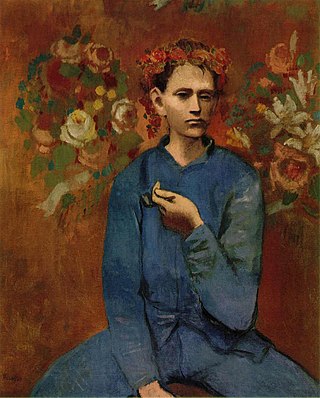
Garçon à la Pipe is an oil on canvas painting by Pablo Picasso. It was painted in 1905 when Picasso was 24 years old, during his Rose Period, soon after he settled in the Montmartre area of Paris. The painting depicts a Parisian adolescent boy who holds a pipe in his left hand and wears a garland of flowers on his head, surrounded by two floral decorations. The subject was a local boy named "P’tit Louis" who died at a young age. The painting is listed as one of the most expensive paintings, after being sold at Sotheby's auction for $104 million on 5 May 2004. It is currently the fifth highest selling painting by Picasso.

The Rose Period comprises the works produced by Spanish painter Pablo Picasso between 1904 and 1906. It began when Picasso settled in Montmartre at the Bateau-Lavoir among bohemian poets and writers. Following his Blue Period – which depicted themes of poverty, loneliness, and despair in somber, blue tones – Picasso's Rose Period represents more pleasant themes of clowns, harlequins and carnival performers, depicted in cheerful vivid hues of red, orange, pink and earth tones.
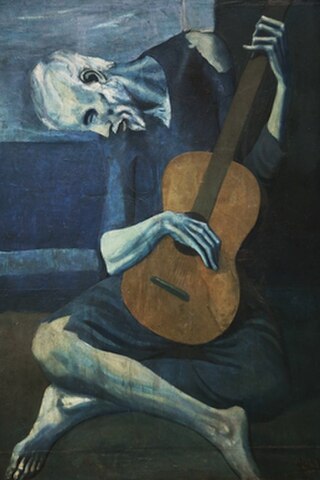
The Blue Period comprises the works produced by Spanish painter Pablo Picasso between 1901 and 1904. During this time, Picasso painted essentially monochromatic paintings in shades of blue and blue-green, only occasionally warmed by other colors. These sombre works, inspired by Spain and painted in Barcelona and Paris, are now some of his most popular works, although he had difficulty selling them at the time.

Picasso's African Period, which lasted from 1906 to 1909, was the period when Pablo Picasso painted in a style which was strongly influenced by African sculpture, particularly traditional African masks and art of ancient Egypt, in addition to non-African influences including Iberian sculpture, and the art of Paul Cézanne and El Greco. This proto-Cubist period following Picasso's Blue Period and Rose Period has also been called the Negro Period, or Black Period. Picasso collected and drew inspiration from African art during this period, but also for many years after it.
Laurel Zuckerman is an American author based near Paris, France.
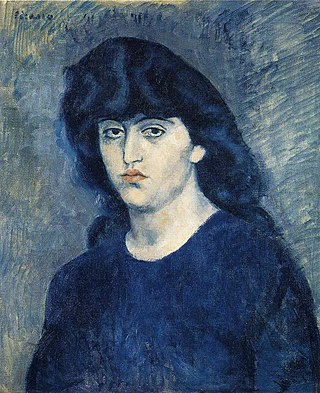
Portrait of Suzanne Bloch is an oil on canvas painting executed by the Spanish artist Pablo Picasso in Paris in 1904, towards the end of his Blue Period. The subject, Suzanne Bloch, was a singer known for her Wagner interpretations, and the sister of the violinist Henri Bloch. The painting is housed in the São Paulo Museum of Art.

Jeune garçon au cheval is an oil on canvas painting by Pablo Picasso. The painting is housed in the Museum of Modern Art in New York. It was painted in Picasso's Rose Period from 1905 to 1906, when he was still a struggling artist living in Paris. The painting is a study for a much larger composition that Picasso never completed.
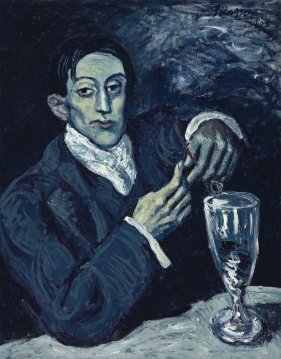
Portrait of Angel Fernández de Soto is a portrait by Spanish artist Pablo Picasso completed in 1903 during his Blue Period. The oil painting depicts Picasso's friend and fellow painter, Angel Fernandez de Soto, in a bar with a glass of absinthe. The painting was previously owned by musical theatre composer Andrew Lloyd Webber. On 23 June 2010, the painting was sold at auction for £34.7 million.
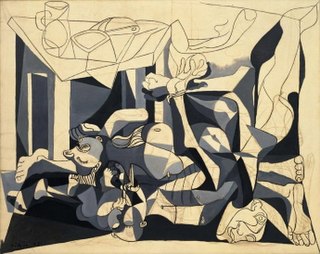
The Charnel House is an unfinished 1944–1945 oil and charcoal on canvas painting by Spanish artist Pablo Picasso, which is purported to deal with the Nazi genocide of the Holocaust. The black and white 'grisaille' composition centres on a massed pile of corpses and was based primarily upon film and photographs of a slaughtered family during the Spanish Civil War. It is considered to be the second of three major anti-war Picassos, preceded by Guernica in 1937 and succeeded by Massacre in Korea in 1951. The painting is housed in the Museum of Modern Art in New York City.

Family of Saltimbanques is a 1905 oil on canvas painting by Pablo Picasso. The work depicts six saltimbanques, a kind of itinerant circus performer, in a desolate landscape. It is considered the masterpiece of Picasso's Rose Period, sometimes called his circus period. The painting is housed in the collection of the National Gallery of Art in Washington, D.C.
Woman Ironing is a 1904 oil painting by Pablo Picasso that was completed during the artist's Blue Period (1901—1904). This evocative image, painted in neutral tones of blue and gray, depicts an emaciated woman with hollowed eyes, sunken cheeks, and bent form, as she presses down on an iron with all her will. A recurrent subject matter for Picasso during this time is the desolation of social outsiders. This painting, as the rest of his works of the Blue Period, is inspired by his life in Spain but was painted in Paris.

Au Lapin Agile is a 1905 oil on canvas painting by Pablo Picasso. It depicts the interior of the Lapin Agile, a famous cabaret club in the Montmartre area of Paris. The composition was produced during Picasso's Rose Period and includes a self-portrait of the artist who frequented the club in his youth. The painting is listed as one of the most expensive paintings after achieving a price of $40.7 million at Sotheby's auction on 27 November 1989. It is housed in the collection of the Metropolitan Museum of Art in New York City.
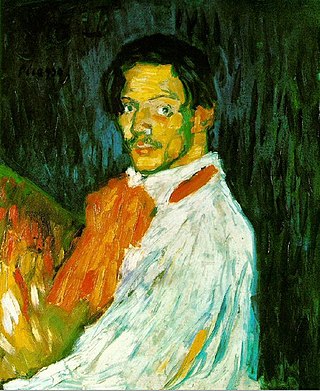
Yo, Picasso, is an oil-on-canvas painting by Pablo Picasso, which he painted in 1901. It is a self-portrait of the artist that depicts him in his youth, aged 19. The painting was created at the beginning of Picasso's Blue Period. On 9 May 1989, the painting sold at Sotheby's, achieving a price of $47.85 million, making it one of the most expensive paintings sold up to that date.

Young Girl with a Flower Basket is a 1905 oil on canvas painting by Pablo Picasso from his Rose Period. The painting depicts a Parisian street girl, named "Linda", whose fate is unknown. It was painted at a key phase in Picasso's life, as he made the transition from an impoverished bohemian at the start of 1905 to a successful artist by the end of 1906. The painting is listed as one of the most expensive paintings, after achieving a price of $115 million when it was sold at Christie's on 8 May 2018. It is currently the third highest selling painting by Picasso.

Acrobat and Young Harlequin is a 1905 oil on canvas painting by Pablo Picasso. Painted toward the end of Picasso's Blue Period and the outset of his Rose Period, the work displays characteristics of both, with its melancholic subject and its blue and rose palette. Picasso created the painting while at the Le Bateau-Lavoir, his home and studio in Montmartre, Paris.

Famille d'acrobates avec singe is a 1905 painting by Pablo Picasso. It depicts a family of travelling circus performers during an intimate moment. The work was produced on cardboard using mixed media: gouache, watercolour, pastel and Indian ink. It is held by the Gothenburg Museum of Art in Gothenburg, Sweden. The work was painted at a key phase in Picasso's life, as he made the transition from an impoverished bohemian at the start of 1905 to a successful artist by the end of 1906.

Girl on a Ball or Young Acrobat on a Ball is a 1905 oil on canvas painting by Pablo Picasso, which he produced during his Rose Period. It depicts a group of travelling circus performers during a rehearsal, with a primary focus on two contrasting figures. It has been housed in the collection of the Pushkin Museum in Moscow since 1948.
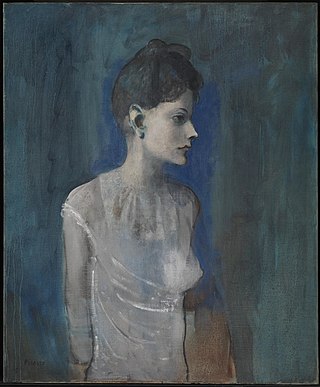
Girl in a Chemise is an oil-on-canvas painting created c. 1905 by Pablo Picasso. It is a portrait of a girl, whom experts believe to be Madeleine, Picasso's girlfriend during this period. Stylistically, the painting belongs to Picasso's Rose Period, although it is predominantly blue in tone. The painting is particularly remarkable for the presence of an earlier portrait of a young boy hidden beneath the surface, which Picasso transformed into the girl by making some subtle changes. The portrait has been housed in the collection of the Tate since 1933.
















